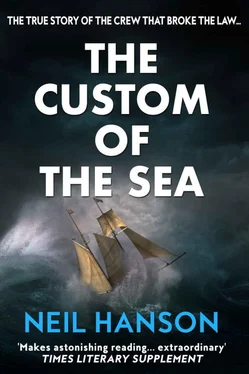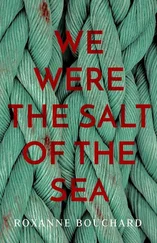They were rescued by an American brig before any further killings could be carried out. In their desperation to attract the attention of the crew, some of the survivors even waved O’Brien’s hands and feet at them. After twenty days adrift, eleven of the original crew of eighteen were still alive, but many were so frost-bitten that they were never able to work again.
The survivors landed in Falmouth on 6 January 1838. They were released without charge and allowed to returned home. The story was reported in many of the West Country papers, and in The Times , and even half a century later, it remained a well-known and often-told tale in Falmouth taverns.
Certain features recurred in almost every instance of cannibalism among seamen. Not only was the custom of drawing lots almost universally practised, but the way the lots fell also revealed a curious consistency. The American whaling ship, the Essex , was true to type. She sank in the South Pacific on 20 November 1820 after being rammed repeatedly by a whale — the incident that inspired Melville to write Moby Dick . The crew had time to salvage some supplies, then they took to three whaleboats and sailed away from the sinking ship. Exactly a month later they sighted land — Henderson Island in the Pitcairns. It was uninhabited and the only food they could discover was peppergrass and the eggs of seabirds.
There was neither enough food nor fresh water to sustain more than a handful of them. Three men chose to remain there and were later rescued by a passing ship, but the rest relaunched their boats on 27 December and sailed on, hoping to reach Easter Island. On the night of 12 January one of the boats became separated from the others during a storm.
The crews of all of them were soon forced to resort to the custom of the sea. In one, only one man was eaten, though another two died of starvation before the three survivors were rescued by the brig Indian on 18 February.
The occupants of the other two boats fared even worse, and as many as eight people were eaten by their starving crewmates.
On the 14th January, the whole stock of provisions belonging to the second mates boat was entirely exhausted. On the 25th, the black man, Lawson Thomas, died and was eaten by his surviving companions… The Captain and his crew were in the like dreadful situation… Another coloured man, Charles Shorter, died and his body was shared for food between the crews of both boats. On the 27th, Isaiah Shepherd, a black man, died in the second mate’s boat and on the 28th another black man named Samuel Reed died out of the Captain’s boat. The bodies of these men constituted their only food.
Only two men remained alive in the second mate’s boat when it, too, lost contact with the other one. It was never seen again. The captain, George Pollard, was one of only two survivors from the remaining boat.
On the 1st of February, having consumed their last morsel, the Captain and the three other men that remained with him were reduced to the necessity of casting lots. It fell upon Owen Coffin to die… On the 11th, Braxilla Ray died. The Captain and Charles Ramsdell, the only two that were then left, subsisted on the bodies until the morning of the 23rd of February, when they fell in with the ship Dauphin.
They had been adrift for ninety-five days since the wreck of the Essex . That account, based solely on the captain’s version of events, once more exposes but does not comment upon one of the more revealing facts about the vast majority of incidents in which the custom of the sea was practised. The people who, according to the later accounts of the survivors, either died of natural causes and were then eaten, or who were the unlucky ones when lots were drawn, were almost invariably the weakest, most vulnerable, disliked or isolated individuals. Slaves were eaten first, black men before white, women before men, passengers before crew, unpopular crew members before the rest.
The hierarchy of the ship’s complement was also followed: cabin boys or apprentices were eaten first, ‘idlers’ — carpenters, cooks, sailmakers and boatswains, who because of their specialist tasks, did not keep watches and received higher pay — came next, and ordinary seamen before officers.
It stretches credulity to breaking point to believe that natural causes or the random drawing of lots can always have produced such fortunate results… for those who survived. It is clear that many deaths from natural causes were actually murder and that many — the majority of — instances of lots being drawn were rigged or fabricated afterwards to conceal the murder of a disliked or disposable member of the company.
If the custom of the sea was accepted without comment among seafaring communities, the reaction of the Victorian establishment was very different. Many of the horrors of the Victorian underworld, such as child prostitution, passed largely unnoticed, but the very openness and honesty of seamen who had resorted to the custom of the sea forced it to public attention.
Polite society abhorred the idea of Englishmen practising cannibalism like savages, in defiance of the law and Christian morality. Under the selfless Victorian ideal of service to society and to God, men were expected to die nobly for others, not kill them that they might themselves survive.
There was one famous example. The iron-hulled troopship the Birkenhead sailed from the naval base of Simonstown in South Africa for Port Elizabeth on 25 February 1852, with 648 people on board. In addition to a full complement of fighting men, there were also many wives and children. At two the following morning the ship hit a reef in shark-infested waters off Danger Point.
A heavy poop and forecastle had been added to the ship when she was converted from a frigate to a paddle-steamer and the military authorities had also ordered holes to be cut in the watertight bulkheads below decks to increase the available room for troop-carrying. As a result, when the rocks pierced the hull, the entire forward troop accommodation was flooded in seconds. Most of the men on the lower troop deck drowned in their hammocks. Sixty who survived were sent to man the chain pumps on the upper troop deck, the remaining soldiers were lined up on the poop deck aft.
An attempt to use the engines on full astern to lift the ship off the rocks merely increased the size of the hole in the side. As the women and children were helped into one of the ship’s two cutters, the rest of the troops stood to attention. ‘Ensign Lucas and Cornet Bond had the brutal task of detaching the wives and children from their husbands still standing motionless in the ranks, knowing that their men were being left behind to die.’
The horses were thrown overboard from the port gangway and a handful made the shore, despite repeated shark attacks. The first cutter with all the women and children pulled away a short distance. The second with about thirty men and a gig holding a few more were also lowered. The boats had barely got clear when the funnel crashed on to the deck, crushing the men who were trying to launch the remainder of the boats. Fifty of the sixty men still manning the pumps were drowned at once. By a miracle the others managed to struggle on deck.
The captain, Robert Salmond, ordered the ship to be abandoned but the troop commander, Major Alexander Seton of the 74th Highlanders, and Captains Wright and Girardot countermanded the order at once, afraid that the men would swamp the boats that had already been launched. The soldiers were ordered to stay where they were, and only three made a move from the stationary ranks, jumping over the rail into the sea. All three were drowned or eaten by sharks as the ship’s boats moved away.
Shortly afterwards the Birkenhead split in half and sank. Those not sucked down by the downdraught of the wreck clung to any piece of wreckage they could find or struck out for the shore. Most of the troops, however, could not swim and even those who could struggled to fight their way through the dense seaweed under constant attack from the packs of marauding sharks.
Читать дальше











